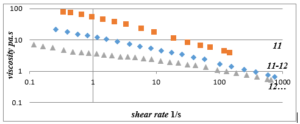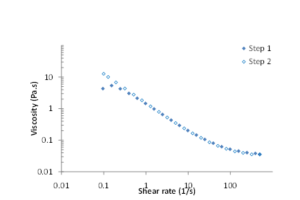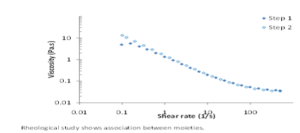Yousif M Alnour. AbdelHakam
Department of chemistry || Faculty of Education || Sudan university of Science and Technology || Khartoum || Sudan
INTRODUCTION
Rheology is the study of the flow and deformation of matter. This interdisciplinary field encompasses many different types of materials and application, both in academia and industry. One of the most challenging and practical areas in which technical strides have been made is dispersion chemistry. Rheology can be used to characterize not only flow properties of a material, but also structural features. The term rheology was coined by Eugene C.Bingham, professor at Lafayette College in 1920. The term was inspired by the aphorism of “every things flows” Plato that saying “all things move and nothing remains still” (Barnes, Jonathan, 1982).
when the shear rate is increased gradually (viscosity in reduced) and when the shear rate is decreased gradually (viscosity increased) the curves show a very similar behavior(Steffe, J. 1996).The shear thinning behavior may be attributed to the fact that: the structures in the gum are most probably three dimensional coils. The shape of each coil appears to be roughly spherical and each one is entangled many times with neighboring macro molecules (Finsher, G. R.,etal, 1983). During the shearing process, the molecules are oriented into the shear direction as well as the shear gradient direction, on doing so the molecules disentangle to a certain extent and this lower their flow resistance and hence increase the freedom of movement of individual chains (Garti, N. 1999). The aims of this were is identify specification parameters of Prosopis Chilensis gum.
MATERIAL AND METHOD
Tow composite samples of Prosopis Chilensis gum were prepared by random mixing of selected samples to represent each location. The samples were ground using mortar and pestle and kept in separate container for prepare Rheological. The methodology includes international (Anderson etal, 1983, Osman etal, 1993).
RESULTS AND DISCUSSIONS
Figure (1) summarize the Rheological performance of the two composite samples 11(Elsageea) and 12 (Krtob), Rheological properties of Prosopis Chilensis Gum
The profile for variation of viscosity with shear rate: when the shear rate is increased gradually (viscosity inreduced) and when the shear rate is decreased gradually (viscosity increased) for each concentration of each sample exactly coincide and doesn’t make any loop for all values of shear rate Figure 1 this indicates some sort of reversible deformation in the molecules due to the shear rate and hence assists the elastic behavior of the gum (no energy is dissipated during the shearing) at very low shear rate (0.01 – 0.1 Hz) the viscosity of the gum are almost constant for the considered concentrations(Chmiel, H., etal, 1990).
The Comparison of for viscosity decrease steadily with increasing shear rate till the shear rate reaches a value of (tan (y) . And exhibited a non-Newtonian behavior in this region; therefore, a limiting Newtonian higher-shear viscosity could be estimated by fitting the experimental results to the Sisko model (Sisko, 1958). This model predicts Newtonian response at high-shear rate.
Where (n) is the apparent viscosity (Pa s), Ks (Pa sn) and ns are the consistency index and the flow index of the Sisko model, respectively; ( ) the shear rate (s-1) and ( ) (Pa s) stand for the so-called infinite-shear rate viscosity. On this region of low shear rate the gum solution exhibit tendency to the viscoelastic properties, where the curve is less steep and a typical Newtonian behavior dominates(Lopes da Silva, J.A., etal, 1999). Figure 2and3 (Yousif M. Alnour,2014). Rheology of the Gum from Acacia tortilis var. tortilis show similar patterns to those Rheological Properties of Prosopis Chilensis Gum sample 11(Elsageea) and 12 (Krtob).

Fig (1) Rheology Performance of sample Prosopis Chilensis gum 11(Elsageea) and 12 (Krtob).

Fig (2) Rheology Performance of the Gum from Acacia tortilis var. tortilis (Algetina43347).

Fig (3) Rheology performce of the Gum from Acacia tortilis var. tortilis (Wadbnda43348).
CONCLUSION
- The Prosopis Chilensis gum were the two locations show similar Rheological.
- The Prosopis Chilensis gum has moderate protein content.
ACKNOWLEDGMENT
The Author would like express the Malaysia University of Science for Technical support.
REFERENCES
- Anderson, D. M. W., Bridgeman, M. M. E., Earquhar, J.G.K. and Mc Nab, C.G.A., (1983). The international tree Crop Journal, 2, 245-254.
- Barnes, Jonathan(1982).The Prescoratic Philosophers. ISBN9780415050791.
- Chmiel, H., Anadere, I., and Walitza, E. (1990). Clinical Hemorheology10, 363-374.
- Finsher, G. R., Stones, B. A. and Clarke, A. E., (1983). Ann. Rev. Plant physical., 34, 47.
- Garti, N. (1999). Journal of Dispersion Science and Technology, 20, 327-355.
- Osman, M.E., Menzies, A. R., Williams, p. A., Phillips, G.O., and Baldwin, T.C. (1993). Carbohydrate Research, 246, 303-318.
- Lopes da Silva, J.A., and Rao, A.M. (1999). In A. M. Rao (Ed), Rheology of fluid and semisolid foods principles and applications Aspen Publishers, Incpp. 319-368.
- Sisko, A.W. (1958). Industrial Engineering and Chemsitry, 50, 1789-1792.
- Steffe, J. (1996). Rheological methods in food process engineering East lansing, MI, USA, Freeman, Press pp. 200-202.
- Yousif M. Alnour 2014 PhD, thesis, in Chemistry Alzaiem AlAzhary University.